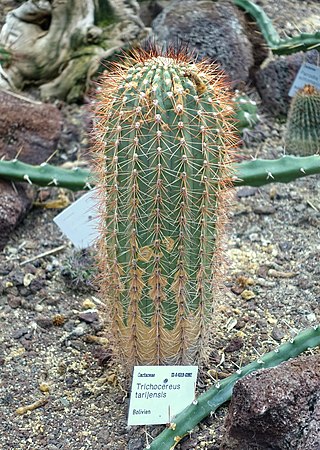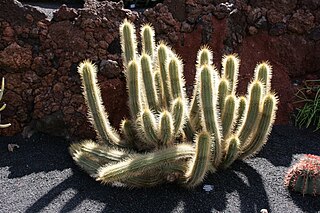
Browningia is a genus of cacti, comprising 11 accepted and 3 unresolved species. It is named for Webster E Browning (1869-1942), director of the Instituto Inglés, Santiago, Chile.

Neoraimondia is a genus of medium to large cacti from Peru. The genus is named after the Italian-born Peruvian explorer, naturalist, and scientist, Antonio Raimondi.

Pediocactus is a genus of cacti native to the Western United States. The genus comprises between 6 and 11 species, depending upon the authority. Species of this genus are referred to as hedgehog cacti, though that name is also applied to plants from the genera Echinocereus and Echinopsis. Species may also be referred to as pincushion cacti, a common name which is also applied to other genera.

Uebelmannia is genus of cacti, native to southeast Brazil. In a 2023 classification of the tribe Cereeae, it was placed as the only genus in the subtribe Uebelmanniinae, having formerly been placed in the subtribe Rebutiinae.

Weberocereus is genus of cacti. It produces a green and white flower and is found mainly in Costa Rica and Nicaragua.

Cephalocereus is a genus of slow-growing, columnar-shaped, blue-green cacti. The genus is native to Mexico.

Discocactus is a genus of tropical cacti. Discocactus plants are endemic to southern Brazil, eastern Bolivia, and northern Paraguay. These species are in the risk of extinction in the wild.

Espostoopsis is a monotypic genus of cactus containing the single species Espostoopsis dybowskii. The generic name is formed from Greek opsis meaning "view", referring to its resemblance to the genus Espostoa, with which it is often confused. The plant is only known from northern Bahia, Brazil.

Samaipaticereus is a monotypic genus of cactus containing the sole species Samaipaticereus corroanus. It is known only from East Andean Bolivia and Peru.

Soehrensia schickendantzii is a cactus found in northwestern Argentina in provinces of Salta and Tucumán at elevations of 1600 to 3200 meters.

Lophocereus marginatus is a species of plant in the family Cactaceae. It is sometimes called Mexican fencepost cactus.

Lobivia backebergii is a species of flowering plant in the cactus family Cactaceae, native to eastern Bolivia and southern Peru.

Soehrensia thelegona is a species of cactus in the Soehrensia genus.

Lobivia ancistrophora is a species of cactus. It has a globular shape, few spines, with large, white flowers attached to long, green tubes. It occurs in Bolivia, at altitudes of 600–1800 metres. Under its synonym Echinopsis ancistrophora it has gained the Royal Horticultural Society's Award of Garden Merit.

Soehrensia tarijensis, is a species of Soehrensia, in the cactus family. It is native to Bolivia and northwestern Argentina.

Leucostele deserticola is a species of cactus native to South America.

Leucostele skottsbergii is a species of Leucostele found in Chile.

Soehrensia thelegonoides is a species of Soehrensia found in Argentina.

Brasilicereus phaeacanthus is a species of Brasilicereus found in Brazil.

Micranthocereus purpureus is a species of Micranthocereus found in Brazil.























